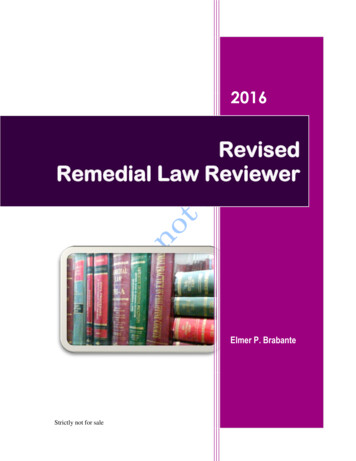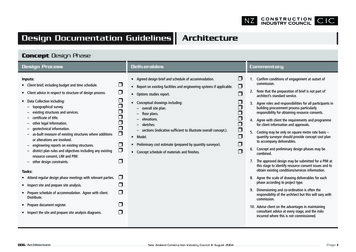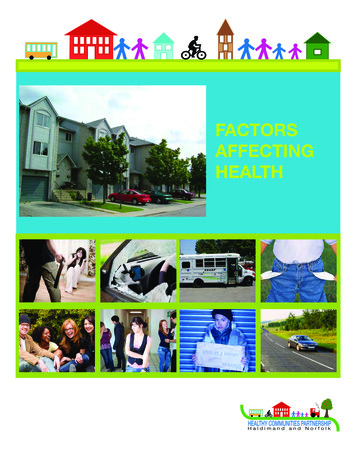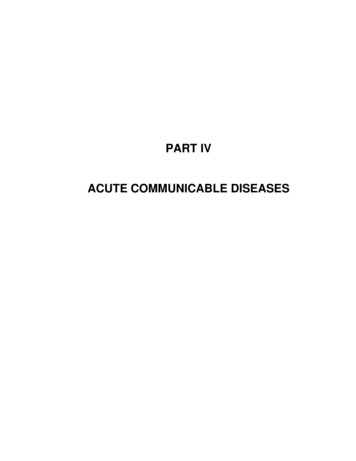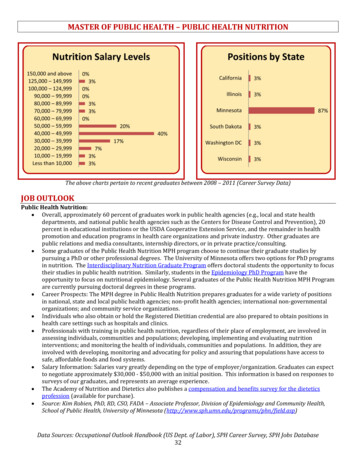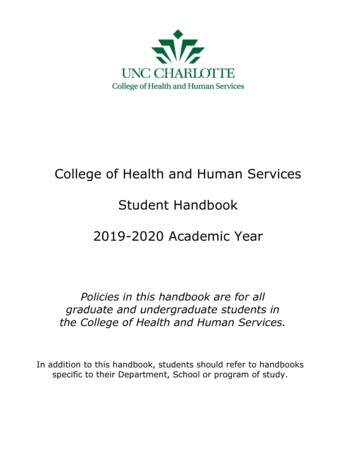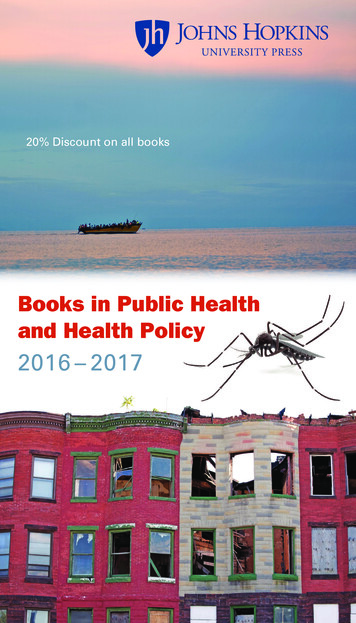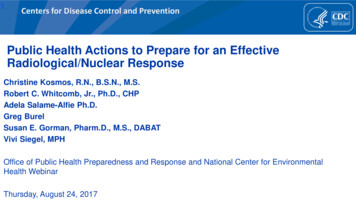
Transcription
1Centers for Disease Control and Preventionand Relevance to Today’s DiscussionPublic Health Actions to Prepare for an EffectiveRadiological/Nuclear ResponseChristine Kosmos, R.N., B.S.N., M.S.Robert C. Whitcomb, Jr., Ph.D., CHPAdela Salame-Alfie Ph.D.Greg BurelSusan E. Gorman, Pharm.D., M.S., DABATVivi Siegel, MPHOffice of Public Health Preparedness and Response and National Center for EnvironmentalHealth WebinarThursday, August 24, 2017
AGENDA Welcome and Opening RemarksCDC Activities and Gotham Shield 2017 Functional ExercisePublic Health Response to Radiological/Nuclear EmergenciesMedical Countermeasures in a Radiological/Nuclear EmergencyCommunications in a Radiological Nuclear EmergencyCDC Next StepsQuestion-and-Answer SessionClosing Remarks
Opening RemarksChristine Kosmos, R.N., B.S.N., M.S.Director, Division of State and Local ReadinessOffice of Public Health Preparedness and Response
Gotham Shield Overview and Relevance to Today’sDiscussionRobert C. Whitcomb, Jr., Ph.D., CHPChief, Radiation Studies BranchNational Center for Environmental Health
FEMA-sponsored functional exercise that examined local, regional, and nationalcapabilities across the prevent, protect, response, and recovery mission areas Designed to educate and prepare the “whole community” for an act of terrorism andcatastrophic incident Incorporated pre-existing exercises under one scenario and control architecture Dates: April 18-28, 2017, & May 9-11, 2017 Prevent/Protect: April 18-23, limited CDC participationResponse: April 24-28, primary window for CDC activities (April 24-27)Recovery: May 9-10, select CDC leader participation
CrawlWalkRunActivities Leading to the Gotham Shield ExerciseTTX #3:IND ResponseFE: GS 17TTX #1:IMS,Activation,and StaffingDrill #1:IMS,Activation,and StaffingSLS:Drill #2:IMS, Nuc/RadIND ResponseAnnexTTX #2:Communications and INDResponseSeminarWorkshopDrill #3:IND ResponseSeminarWorkshopIMS WorkshopIMS Workshop#3#2IMS Workshop #11st Qtr2nd Qtr3rd Qtr4th QtrGoals: Respond quickly and effectively to global public heath emergencies Decrease time to make meaningful response impact Continue to improve efficiency and effective internal/external partnerships
Gotham Shield 2017 Scenario National Planning Scenario (NPS) #1: Nuclear Detonation—Improvised NuclearDevice (IND)Intel indicates a terrorist threat of nuclear detonation—when or where unknownGun-type nuclear device using highly enriched uranium Smuggle into United States Assembled near a major metro center Transport to large city using a van and detonateIND (10-kt) Detonation in large U.S. city Detonation: Ground level at noon Weather: Clear, light haze, and light breeze; no snow or no clouds Casualties: Hundreds of thousands Infrastructure Damage: Total w/n radius of 0.5 to 3 miles Evacuations/Displaced Persons: 100K in area seek shelter (decon required toenter shelters); 250K shelter in place; 1M self-evac Contamination: Various levels approx. 3K square miles Economic Impact: Hundreds of billions Recovery Timeline: Years
What’s the difference between an Airburst andSurface Burst? An airburst is a nuclear detonation in whichthe fireball does not touch the Earth’ssurface These maximize blast effects andminimize fallout. Less debris is suckedup by the mushroom cloud therebyproducing less fallout“Little Boy” A ground burst is a nuclear detonation inwhich the fireball does touch the Earth’ssurface These cause much more debris to besucked up into the mushroom cloud.This radioactive debris then becomesfallout
Example of Radiation Team Activities Content development and review (for Joint InformationCenter products)- Majority of effortAdvisory team environment, food and healthInput - Medical countermeasures Q&AInput - worker safety and healthCRC operational guidanceState and local needsData needs/cost of registry for workers and publicBriefings, conference calls, etc
Examples of Questions that Required MessageDevelopment Is the large number of fatalities unusual? How does this compare to the Japanearthquake?Should we expect more fatalities as a result of this event?How is CDC involved in the investigation of this event?Does the federal government plan to activate their medical countermeasures supply?Do CDC officials receive MCM before the general public?Will points of distribution be set up to pass out medical countermeasures?How soon will CDC provide medical countermeasures to the general public?Why is potassium iodide not relevant to this response?Why is internal contamination not relevant to this response?Will this affect women of childbearing age who want to have children later?Are sanitation workers at risk in picking up soiled diapers and other waste frompeople in the affected area?
Radiation Response Guide for Key Leaders and PublicHealth Decision MakersAdela Salame-Alfie Ph.D.Radiation Studies BranchNational Center for Environmental Health
During a radiation emergency, state and localauthorities will need to quickly assess the degree ofthe hazard and issue the appropriate protectiveactions to people in the affected area.
Terminology – CBRN ThreatsChemical, Biological, Radiological, Nuclear A radiological incident does NOT involve a nucleardetonationA nuclear incident involves a nuclear detonationBoth Can happen in unforeseen locations Apply to all States and jurisdictions
Potential Radiation Events TransportationPower ism
Radiological Dispersal Device (RDD) A device that disperses radioactive material by conventionalexplosive (dirty bomb) or other mechanical means, such as a sprayContamination and exposure hazard
Nuclear Emergencies A nuclear emergency involves the explosion of a nuclear weapon or improvisednuclear device (IND)The explosion produces an intense pulse of heat, light, air pressure, and radiationNuclear explosions produce fallout (radioactive materials that can be carried longdistances by the wind)
Key Information NeededIf nuclear incident: Type of device (IND, statesponsored) Size of device Direction of the plume Radioactive decay (howquickly radiation levelsdecrease) If radiological incident:Type of incident (RDD, RED,transportation, nuclearpower plant, industrial)Radionuclide(s) involvedHalf-life of radionuclidePhysical form of material(liquid, solid, gas)Are medicalcountermeasures availablefor this radionuclide
Key Information Needed Impacted areas Extent of contamination Radiation levels Critical infrastructures andservices Primary radiation hazards(exposure/contamination) Other hazards (fires, collapsedbuildings, secondary devices, )Impacted population Number living/working in thearea Transient (working/visiting) Special events (sports or otherevents) Response assets needed to addresshazards identified (search andrescue, fire, hazmat, medical )
Key Information NeededKey Information Needed Safety precautions considerations: First responders (police, fire,EMS) First receivers and hospitalpersonnel Other emergency workers andvolunteers (public works, busdrivers aiding evacuation, staffat CRCs/shelters, etc.) CommunicationsAvailable channelsTechnical experts (SME andcommunications) who can craftmessages Agencies to contactFor notificationFor assistance
Information Supports Decision Making!Determine the most appropriate initial protective action for people in the affected areaFor accidents that evolve slowly, such as a nuclear power plant: It may be possible to evacuate people from an area before contamination getsthere, but Evacuating large populations presents other hazards may put people at higherrisk than the potential exposure So, make sure to consider potential risks of evacuation before issuing evacuationorder
Protective Action Recommendations/DecisionsFor incidents that develop quickly (such as terrorist act) Best course of action is to shelter-in-place until radiation experts assess the hazard andprovide further instructions An RDD is unlikely to distribute enough contamination to present a serious exposurehazard but leaving a safe structure will put people at risk for internal and externalcontaminationShelter-in-place is the recommended protective action after an IND, because: Radioactive fallout from an IND presents a serious exposure hazard - going outside willexpose people to potentially very high levels of radiation Staying inside a sturdy building provides shielding and reduces exposure Radioactive fallout loses energy quickly and becomes less dangerous as time passes After 24-48 hours, radiation levels will decrease to a fraction of initial levels
Roles and Responsibilities Response by federal Agencies is outlined in Nuclear/Radiological Incident Annex tothe Response and Recovery Federal Interagency Operational Plans (NRIA) of theNational Response Framework (NRF)--Defines roles and responsibilitiesDiscusses specific authorities, capabilities and assets that the federal governmentcan bring to bearDiscusses how the assets will organize and operate in conjunction with eachother and with local and state response partners
Public Health Responsibilities Conducting population monitoringInitiating health surveillance and epidemiological investigations for workers and thepublicCoordinating the distribution of medical resources/countermeasuresCommunicating guidance regarding use of altered standards of care and managingscarce resources
Population Monitoring Likely to be the most challenging responsibility for state and local public health.Population monitoring begins soon after a radiation incident is reported and continuesuntil all potentially affected people have been monitored and evaluated for:--Need for medical treatmentPresence of radioactive contamination on the body or clothing (externalcontamination)Intake of radioactive materials into the body (internal contamination)Removal of external or internal contamination (decontamination)Radiation dose received and resulting health risk from the exposureLong-term health effects
Population Monitoring (cont’d) These assessments, except for the evaluation of people for long-term health effects,should be accomplished as soon as possible following the incidentHealth officials will need to establish a population registry and conduct epidemiologicinvestigations to evaluate people for long-term health effects. This process may spanmultiple decadesWhile local health agencies may initiate population monitoring, state and federalassets will be needed to augment local resources
Considerations for Population Monitoring after an IND Population monitoring activities and decontamination services should remain flexibleand scalable to reflect the prioritized needs of individuals and availability of resourcesat any given time and locationThe immediate priority of any population monitoring activity is identification ofindividuals whose health is in immediate danger and requires urgent careThe primary purpose of population monitoring following a nuclear detonation isdetection and removal of external contamination. In most cases, externaldecontamination can be self performed if straightforward instructions are providedPrevention of acute radiation health effects should be the primary concern whenmonitoring for radioactive contaminationRadioactive contamination is not immediately life /20130726-1821-25045-3023/planning guidance for response to a nuclear detonation 2nd edition final.pdf
Phases of Radiation Emergency ResponseEarly Phase Those actions required for life-saving and immediate protection from radiation andradioactive materials Often based on limited information or projections (modeling)Intermediate Phase Typically involve protecting individuals from chronic exposure to radioactive materialson the ground, bodies of water, or incorporated in or deposited on food productsLate Phase Activities designed to return the affected area to normalcy
Federal AssetsDepartment of Energy (DOE) National Atmospheric Release Advisory Center (NARAC) Predictive plots and maps showing affected areas Radiological Assistance Program (RAP) On-call radiation protection personnel from national laboratories Respond at the request of state officials Aerial Measuring System (AMS) Rotary- and fixed-wing aircraft outfitted with radiation detection equipment Federal Radiological Monitoring and Assessment Center (FRMAC) Multiagency organization responsible for coordinating radiological monitoring,sampling and assessment activities Radiation Emergency Assistance Center/Training Site (REAC/TS) Medical asset that provides medical advice, training, and on-site assistance fortreatment of radiation injuries
Federal Assets Environmental Protection Agency (EPA)- RadNet- Network of 130 radiation monitoring stations. Provides real time radiationmonitoring in all 50 states- Monitors air, precipitation, drinking water samples Airborne Spectral Photometric Environmental Collection Technology (ASPECT)- Fixed-wing aircraft that provides real-time chemical and radiological monitoring- Can deploy within nine hours of notification Radiological Emergency Response Teams (RERT)- Works with federal, state and local agencies to monitor radioactivity and clean upaffected areas
Federal Assets Advisory Team for Environment, Food and Health (Advisory Team)- Representatives from EPA, USDA, FDA, and CDC plus other agencies as needed- Interprets information provided by FRMAC, NARAC, and other resources- Provides recommendations to the coordinating agency and local/state decisionmakers regarding matters of health (including animal health), the environment andfood Advice includes:- Interpretation of EPA Protective Action Guides (PAGs)- Actions to minimize contamination of food and water- Actions to minimize ingestion of contaminated food and water- Relocation of members of the general public- Return of the general public to areas which had been previously evacuated
Community Reception Center (CRC) Drill ToolkitMain Features: Customizable templates for all aspects of a drill, fromplanning to conduct to evaluation More than 100 different contamination cards for actorssimulating affected individuals Demographic and behavioral cards designed to helpplanners incorporate the needs of special/vulnerablepopulations in the drill Compliant with U.S. Department of HomelandSecurity’s Homeland Security Exercise and EvaluationProgram (HSEEP) guidance*Centers for Disease Control and Prevention (CDC). Population Monitoring in Radiation Emergencies: A Guide for State and Local Public Health Planners, SecondEdition. 2014. 10 May. 2016 monitoring-guide.pdf
Internal Contamination Measurements – Urine BioassayRadiation Laboratory Methods (bioassay): Rapidly identifies and quantifies specific radionuclides in people potentiallycontaminated in a radiological or nuclear incident Provides critical information for effective medical management of individuals byassessing risk for medical management and follow-up Provides information for population monitoring (populations and population subgroups) Provides “negative” results for people who think that they may be contaminated butare not truly contaminated
CDC Laboratory Bioassay MethodsBased on: A “spot” urine sample of 10 mL or less (radionuclide dependent) Rapid “screening” methods for gamma emitters and alpha/beta emitters Measurement of 22 priority threat radionuclides (identification andquantification) CLIA-compliant analytical methods Total laboratory throughput of 300 to 500 samples per day (radionuclidedependent) Uses 6 different analytical technologies for the 22 radionuclides Method detection limits based on the NCRP 166 Clinical Decision Guide for achild or pregnant woman with sample collection 5 or more days postcontamination timeNCRP 166: Population Monitoring and Radionuclide Decorporation Following a Radiological or Nuclear Incident
Medical CountermeasuresGreg Burel, DirectorSusan Gorman, Associate Director for ScienceDivision of Strategic National Stockpile
Medical Management of Radiation Casualties Some incidents may lend themselves to the use of radioprotective drugsThese drugs work in one of the following waysBlocking internal contamination from being absorbed in particular organs(such as KI)Binding internal contamination to speed up excretion from the body (such asPrussian Blue, DTPA)Stimulating the bone marrow to produce white blood cells (granulocytecolony stimulating factors or G-CSF such as filgrastim, pegfilgrastim, orothers)Some of these drugs work on very specific radionuclides; not all would be usefulin a detonation Depending on the nature of the incident, the distribution ofmedical countermeasures may be widespread (e.g. KI) or very selective (e.g.DTPA)The efficacy of these drugs depends to a large extent on the timeliness ofadministration
Acute Radiation Syndrome Also known as radiation sickness or ARSSerious illness that develops when a person receives a high dose of radiation,usually over a short period of timePeople exposed to radiation will get ARS only if:Radiation dose was highRadiation was able to reach internal organs (penetrating)Person’s entire body, or most of it, received the doseRadiation was received in a short time, usually within minutesSymptoms of ARS include:NauseaVomitingHeadacheDiarrheaSymptoms and severity vary depending on the dose
Treatment of ARS Treatment focuses on reducing and treating infections, maintaining hydration, andtreating injuries and burnsSome patients may benefit from treatments that help the bone marrow recover itsfunctionThe lower the radiation dose, the more likely the person will recover from ARSCause of death in most cases is the destruction of the person’s bone marrow,which results in infections and internal bleedingRecovery process may last from several weeks up to 2 years
Medical Countermeasures for Internal Contaminationand Radiation Injury
Communications in a NuclearEmergencyVivi SiegelEnvironmental Hazards and Health EffectsRadiation Studies BranchNational Center for Environmental Health
Communications in a Nuclear EmergencyRadiation presents communications challenges Radiation is- Invisible- Silent- Odorless- Detected with specialized equipmentRadiation concepts, terms, and risks are poorly understood by the publicRadiation elicits fear and is associated with unsurvivable disaster or cancer
But Effective Communication Saves Lives Decreases illness, injury, and deathHelps response and recovery effortsGives people positive actions to takeReduces rumors and misinformationMinimizes unnecessary visits to hospitalsand other critical facilitiesReduces stigmaInvolve communicators at every stage of preparation and response.
Specific Issues in Radiation Communication Myths and misperceptions Complex terms Confusing units of measurement Countermeasures (when to take, when not to take, how they are distributed) Communications infrastructure limitations – how will you get the messages out?
Lessons Learned from Audience Research The public’s most persistent concern at each stage of thescenario, even in low-risk situation: What should I do toprotect myself and my family?Participants do not like messages that conveyuncertainty by having may, might, or could in themessagePeople overestimate risks and resist “reassuring”messagesPeople do not believe simple measures work (e.g.,decontamination)Many people will not shelter-in-place; will seek family andchildren even when it increases their riskPeople will be more likely to take protective actions ifthey understand whyPregnant and nursing women will follow instructions fromauthorities
Effective Communication StrategiesTo dispel myths and communicate effectively about radiation: Give clear, easy-to-follow protective actions to peopleTailor the actions to the specific audience and geographic areaGive people contextUse comparisonsAcknowledge uncertainty, understanding it is uncomfortable
Communication Tools to Provide ContextCDC Radiation Hazard Scale and Risk Thermometer
Example for Demonstration OnlyAutomated Report: Testing(36.71578,-121.62342)Nuclear Detonation at 03 Jan 2016 23:02 UTCPredicted Area for Potential Radiation Hazard in the Fallout AreaTotal external dose from radioactive fallout during first 24-hour after releaseCategory 5Category 4Category 3Category 2Category 1 10 kt detonation at 0 ft elevation. Areas shown are model predictionsbased on an estimated sourceterm; confirm with measurements. Model assumes that no shelter or other protective actions havebeen taken to decrease exposure.Produced: 06 Jul 2016 22:40 UTCBeta.rcE19694.rcC1Advice & Recommendations: CDC 800-232-6348Example for Demonstration Only
Communicating with Professional Audiences Public health professionals, clinicians, and otherprofessionals have misunderstandings and fearssimilar to the publicLet clinicians and other professionals know how toprotect themselves and the low level of risk theyfaceAddressing contamination issues should not delaytreatment of life-threatening injuries
U.S. Government-Prepared Radiation Messaging Question: How do we coordinate incidentmessages across all levels of governmentduring a large-scale radiological incident? Answer:Agree on messages in advancePut the messages in writingPractice
Example: Potassium Iodide (KI) messagingDo I need to take potassium iodide (KI) if there is a nuclear blast?Local emergency management officials will tell people when to take KI. Ifa nuclear incident occurs, officials will have to find out which radioactivesubstances are present before recommending that people take KI. Ifradioactive iodine is not present, then taking KI will not protect people. Ifradioactive iodine is present, then taking KI will help protect a person'sthyroid gland from the radioactive iodine. Taking KI will not protect peoplefrom other radioactive substances that may be present along with theradioactive iodine.Messages are shared in avariety of formats (Twitter,video PSA, infographic)
If something were to happen tomorrow,how quickly can you get this message out?
CDC Communications Training and Tools for RadiationEmergencies Myths of Radiation: Communicating in Radiation iationmyths.asp Radiation Basics Made s.asp Training for Poison Control Centers onRadiation Risk /RAD ToolKit/Training/#/module5/page1Crisis and Emergency Risk CommunicationOnline and In-Person training x.aspRadiation Hazard hazardscale.aspRadiation pProtective action and educational veactions.aspRadiation sary.asp
CDC Next Steps
Questions & Answers
Please send additional questions to Preparedness@cdc.gov. Have a great evening!Thank You!For more information, contact CDC1-800-CDC-INFO (232-4636)TTY: 1-888-232-6348 www.cdc.govThe findings and conclusions in this report are those of the authors and do not necessarily represent theofficial position of the Centers for Disease Control and Prevention.
IMS Workshop IMS Workshop #2 k 1st Qtr 2nd Qtr 4th Qtr TTX #3: IND Response Seminar Workshop Seminar Workshop 3rd Qtr TTX #1: IMS, Activation, and Staffing FE: GS 17 Activities Leading to the Gotham Shield Exercise Drill #3: IND Response IMS Workshop #1 Drill #1: IMS, Activation, and Staffin
